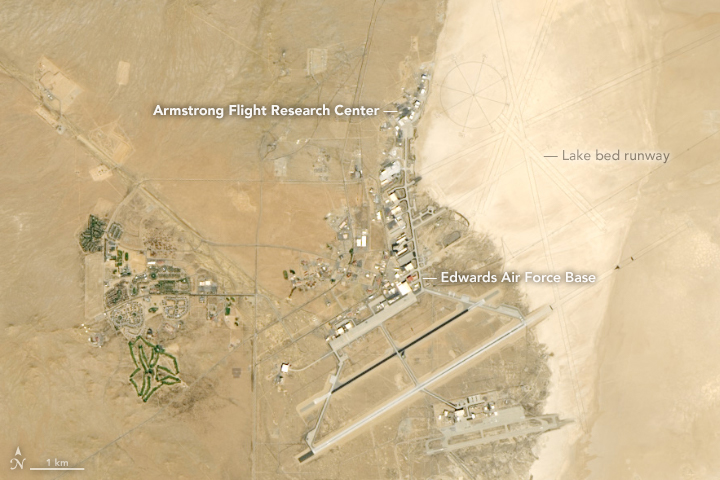
Pushing Limits at Armstrong Flight Research Center
Downloads
- armstrong_oli_2018291_lrg.jpg (3894x3245, JPEG)
Metadata
- Sensor(s):
- Landsat 8 - OLI
- Data Date: October 18, 2018
- Visualization Date: April 22, 2019
In October 1946, thirteen engineers arrived at a small U.S. Army air field at the edge of a dry lake bed in Southern California to work on the experimental X-1 supersonic aircraft. They were some of the first people to work at what would became Armstrong Flight Research Center, one of NASA’s centers for flight research and operations.
The site for Armstrong and the surrounding Edwards Air Force Base was chosen because Rogers Dry Lake offers an expanse of land so smooth and flat that it can be used for emergency landings. As Armstrong has been a major site for testing experimental aircraft, the natural runways on the lake bed have saved hundreds of lives and many aircraft.
Formerly known as Dryden Flight Research Center, Armstrong has been the site of several aviation firsts. In 1947, the X-1 became the first piloted aircraft to go faster than the speed of sound. Armstrong also developed the hypersonic X-15, a rocket-powered plane that holds the record for being the fastest manned aircraft to ever fly. Armstrong tested the first electronically controlled aircraft—the F-8 DFBW—in 1972. And for many years, Armstrong hosted two extensively modified Boeing 747s that carried the Space Shuttle.
Several aircraft based at Armstrong have played key roles in studying Earth. The modified DC-8 jetliner flies a variety of earth science missions, such as Operation IceBridge. The high-altitude ER-2 carries science instruments that have collected data on the ozone hole, hurricanes, and wildfires. Other Armstrong-based aircraft that conduct Earth science research include a Gulfstream C-20A, a B200 King Air, an autonomous Global Hawk, and a remotely piloted Ikhana Predator B.
The Operational Land Imager (OLI) on Landsat 8 captured this image of Edwards Air Force Base and Armstrong Flight Research Center on October 18, 2018. The image showcases the world’s largest compass rose, which was placed there to help pilots land even if navigational equipment fails. Several “drawn on” runways are also visible crisscrossing the surface of the dry lake. The main concrete runway at Edwards Air Force Base, in combination with the lakebed, offers pilots one of the longest and safest runways in the world.
References and Further Reading
- Atlas Obscura World’s Largest Compass Rose. Accessed November 19, 2018.
- NASA History of Armstrong Flight Research Center. Accessed November 19, 2018.
- NASA Overview. Accessed November 19, 2018.
- NASA Armstrong Programs and Projects. Accessed November 19, 2018.
- NASA The Dry Lakes. Accessed November 19, 2018.
- NASA NASA Armstrong. Accessed November 19, 2018.
- National Park Service Rogers Dry Lake. Accessed November 19, 2018.
NASA Earth Observatory images by Lauren Dauphin, using Landsat data from the U.S. Geological Survey. Story by Adam Voiland.
This image record originally appeared on the Earth Observatory. Click here to view the full, original record.